Light as clouds and impossibly tender, Gnudi are what happens when spinach and ricotta skip the pasta and go straight for the good part. These soft dumplings get a quick simmer, then a toss in nutty brown butter with crispy sage: burro e salvia, the Italian answer to doing less, but better.
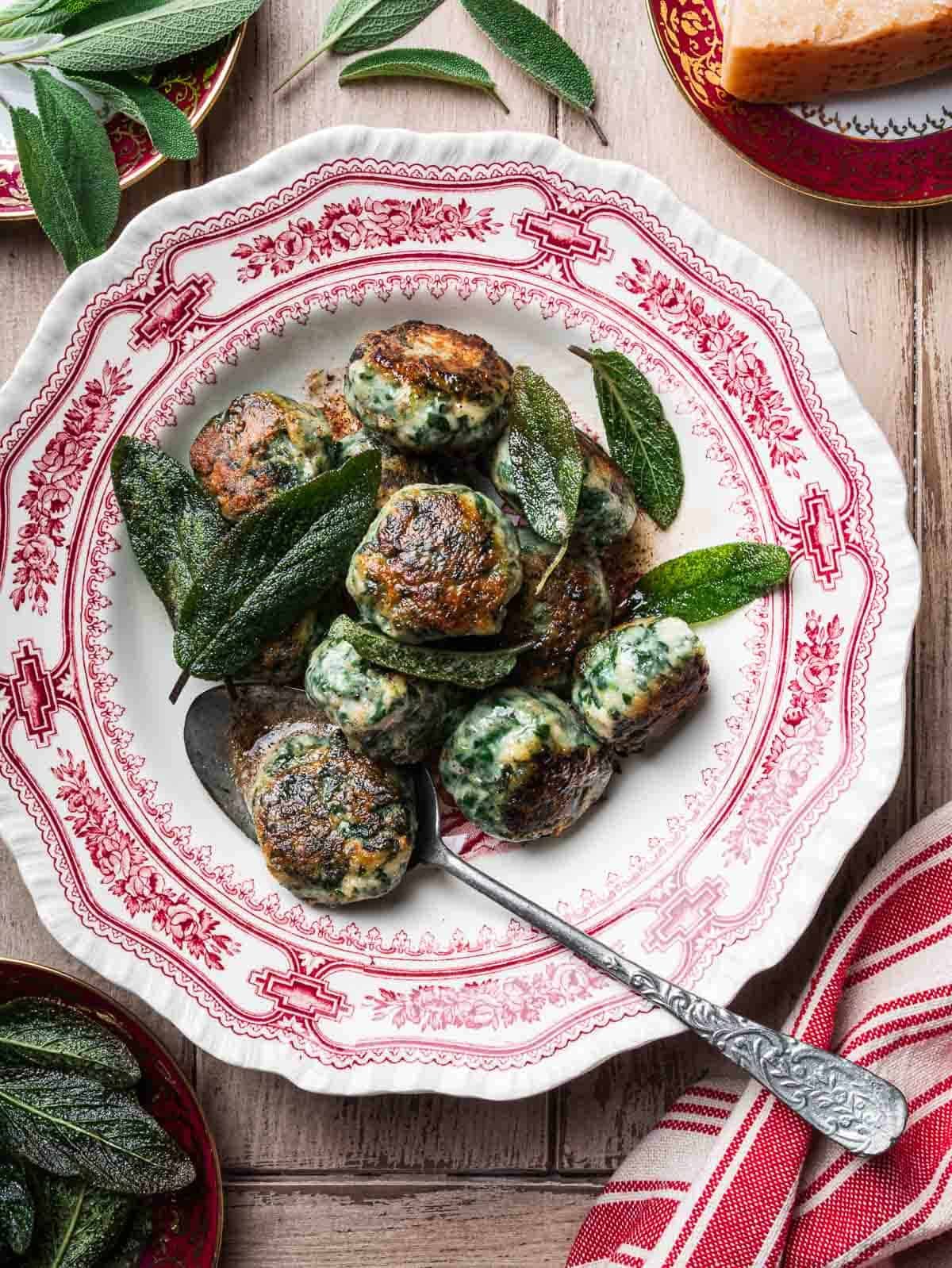
What is Gnudi pasta?
Gnudi (pronounced new-dee) are soft, cloud-like dumplings from Tuscany, made with ricotta and fresh spinach. The name gnudi means “naked” in Italian, a nod to the fact that they’re essentially the filling of stuffed pasta, just without the pasta wrapper. Sometimes called malfatti, or “badly made,” they wear their rustic, imperfect shape with pride. Tender, flavorful, and deeply comforting, gnudi are Italian home cooking at its best.
Why you should try this recipe
- Made with just a few simple ingredients – Ricotta, spinach, garlic, egg flour, and Parmesan: gnudi come together with pantry staples (no hard-to-find, niche ingredients in sight). For dessert, keep it just as simple with a Savoy cake, light, unfussy, and made with only a handful of ingredients.
- Homemade pasta, without the fuss – All the cozy satisfaction of fresh pasta, without the complicated techniques. No rolling, no laminating, if you can mix and shape, you can make gnudi!
- A Tuscan treasure – Delicate, comforting, and too often overlooked, gnudi are one of Tuscany’s most charming (and delicious) secrets. Hungry for more from the region? Try Pici all’Aglione or Eggplant Involtini, both hearty, and just as satisfying.
Get 5 Days of 30-Minute Vegetarian Dinners – FREE!
Sign up TO MY EMAIL SERIES + NEW RECIPES
The ingredients you’ll need

(Note: the full ingredients list, including measurements, is provided in the recipe card at the end of the post.)
- Ricotta cheese – Whole milk ricotta gives the gnudi their creamy, delicate texture. Look for a good-quality, Italian-style ricotta if possible. Leftovers? They’re perfect for a simple Lemon Ricotta Cake.
- Spinach – Fresh spinach offers the best, brightest flavor. Choose bright, perky leaves with no wilt. Frozen spinach works in a pinch, though the flavor won’t be quite as fresh. Any extra can be used in a Spinach And Goat Cheese Quiche, Frittata, or Stuffed Spaghetti Squash.
- Cheese – I use either Parmigiano Reggiano or Pecorino Toscano for this recipe. Grana Padano and vegetarian-grade Parmesan (widely available in the U.S) work well too.
- Sage – Medium to large leaves are best for frying. They hold their shape and crisp up beautifully in brown butter, adding a fragrant, earthy crunch to finish the dish.
Love spinach pasta? Check out my Creamy Cheese Tortellini With Spinach!
How to make Gnudi?
(Note: please see the recipe card below for the complete written instructions and measurements.)

Step 1. Cook the spinach – In a large sauté pan, heat 1 tablespoon of olive oil over medium heat. Add half the garlic and half the spinach, and cook until wilted (Image 1). Repeat with the remaining spinach and garlic. Transfer the cooked spinach to a clean kitchen towel and squeeze out as much moisture as possible (Image 2). Finely chop the spinach on a cutting board.
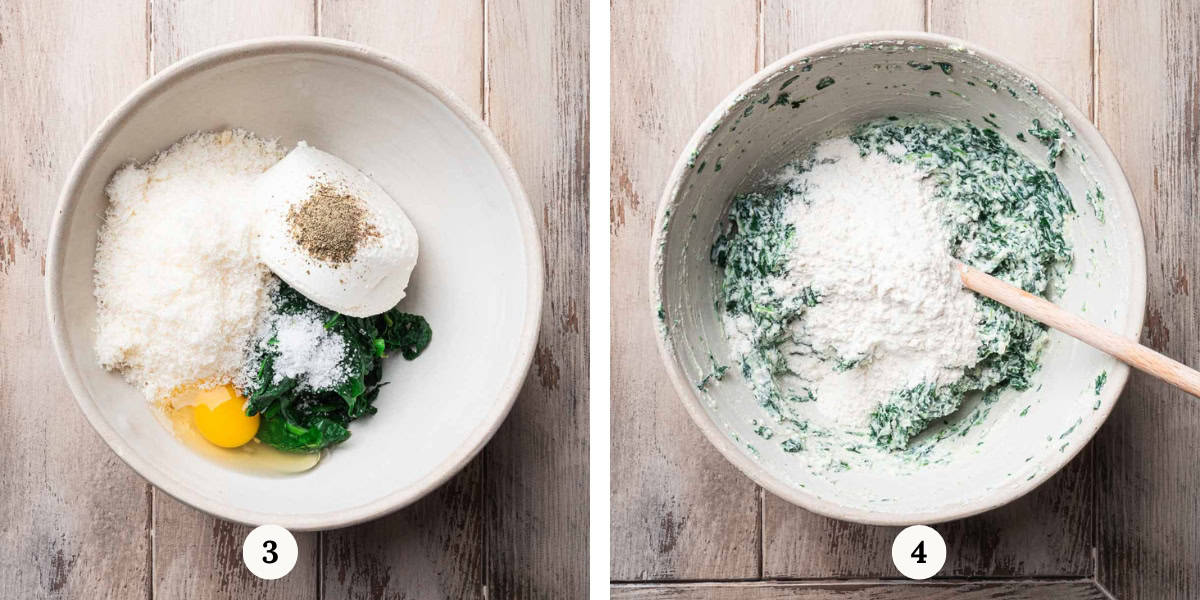
Step 2. Make the dough – In a large bowl, combine the chopped spinach, drained ricotta, egg, Parmesan, salt, and pepper (Image 3). Mix until smooth. Add the flour and stir just until combined (Image 4).
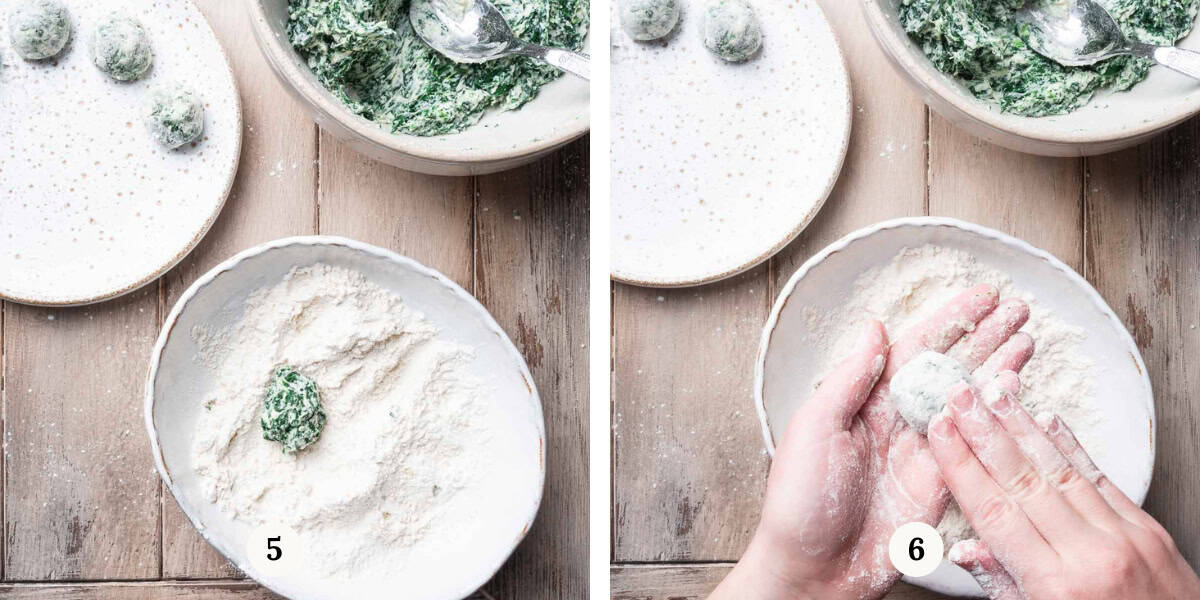
Step 3. Shape the gnudi – With floured hands, shape the mixture into balls about 2 inches (5 cm) wide (Image 5). Roll each one lightly in flour, then roll between your palms to smooth the shape (Image 6). Place on a floured tray or plate.

Step 4. Cook the gnudi – Bring a large pot of salted water to a gentle boil. Add half the gnudi and cook until they float to the surface, about 3–4 minutes. Use a slotted spoon to transfer them to a tray (Images 7 & 8). Repeat with the remaining batch.
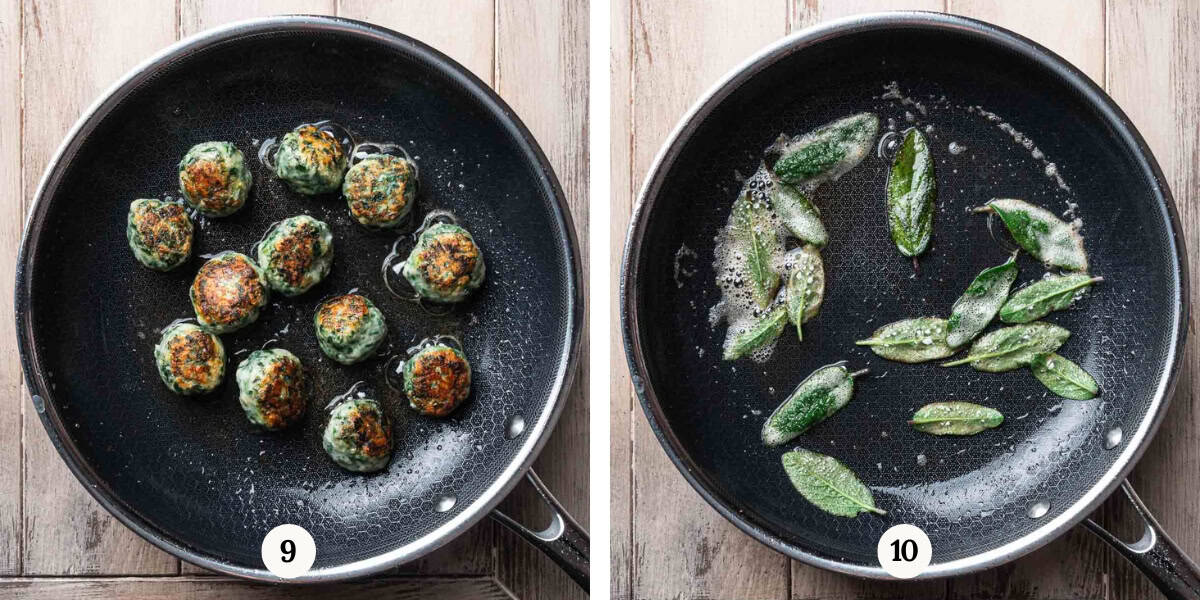
Step 5. Pan-fry and make the brown butter – In a large pan, melt ½ tablespoon of butter and sauté the cooked gnudi until golden on both sides, about 2 minutes per side (Image 9). Work in batches if needed. In a separate small pan, melt the remaining butter until lightly golden. Add the sage leaves and fry until crisp and lightly colored (Image 10).
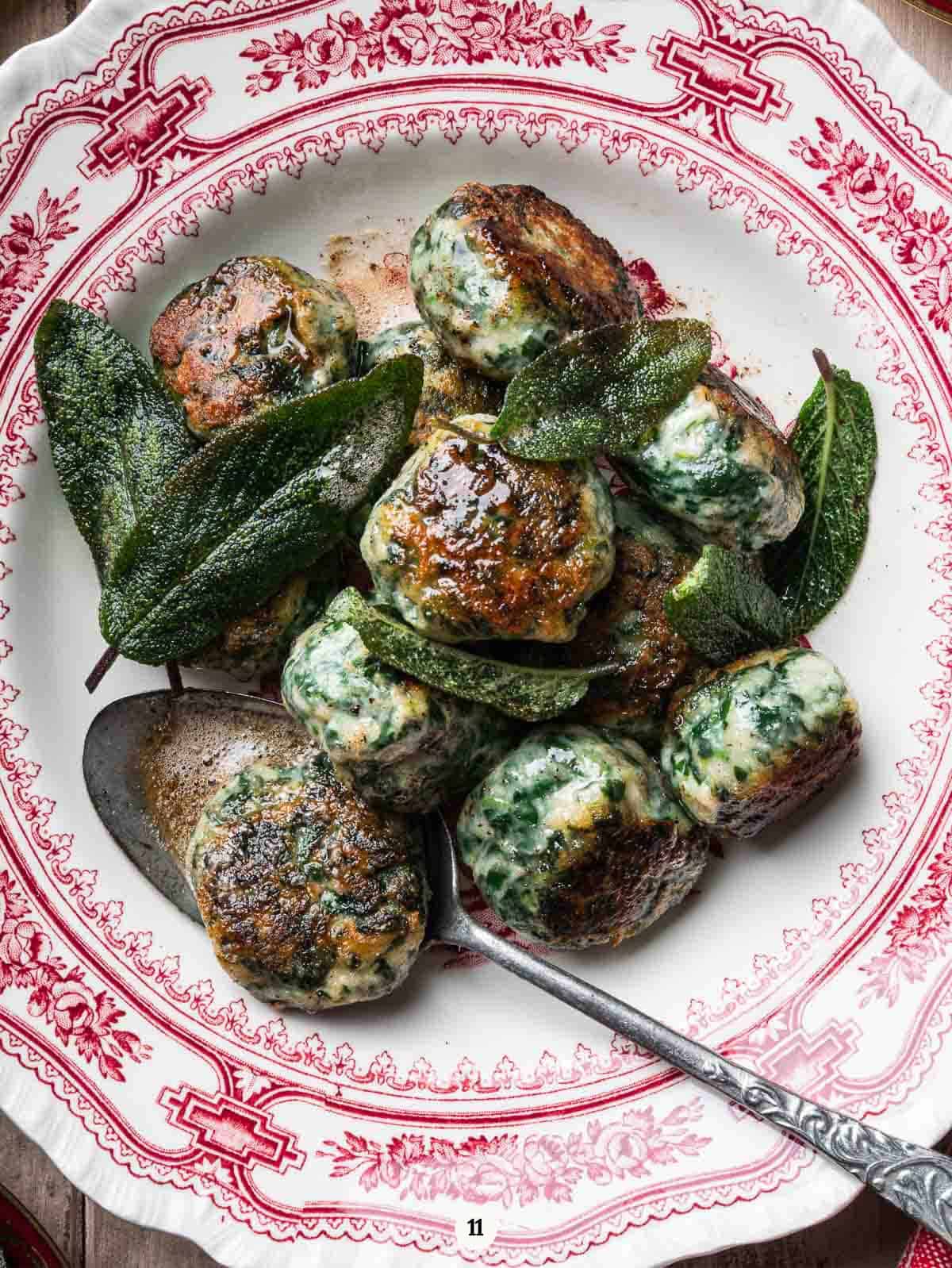
Step 6. Plate and serve – Divide the gnudi among plates or shallow bowls. Spoon the brown butter and crispy sage over the top (Image 11). Serve immediately!
Nim Keys – Useful Gnudi Tips
- Drain the ricotta well – Ricotta holds more moisture than you’d think. Letting it drain before mixing helps the dough hold together and keeps the texture light, not soggy.
- Grate your own cheese – Pre-grated Parmigiano often includes anti-caking agents that interfere with both texture and flavor. Freshly grated cheese (ideally with a Microplane or the fine side of a box grater) melts more evenly and gives a better finish.
- Squeeze the spinach thoroughly – Remove as much liquid as possible from the cooked spinach. Excess moisture will loosen the dough and can cause the gundi to fall apart while cooking.
- Note on coating flour – This recipe uses all-purpose flour for the coating: it’s pantry-friendly and works well. But if you have semolina on hand, use it. It’s a classic Italian touch that adds a slightly firmer exterior.
- Cook right after shaping – Once shaped and coated, gnudi should go straight into simmering water. Letting them rest too long allows moisture to soak into the flour, making them heavy, sticky, and harder to handle.
- Don’t overcrowd the gnudi – Whether boiling or pan-frying, give them space so they cook evenly and hold their shape. Too many in the pot or pan at once can lead to sticking, uneven cooking, and less browning.
- Keep an eye on the sage – The sage fries quickly, so stay close. As soon as the leaves turn lightly golden and crispy, remove the pan from the heat to prevent burning. Serve right away.
Wine Pairing🍷
TUSCAN RED WINE
Sangiovese is the star red grape of Tuscany, and it’s no surprise that it pairs beautifully with Gnudi. Its bright acidity and earthy, iron-tinged structure echo the mineral depth of spinach and cut right through the richness of ricotta and brown butter.
Wine Appellation Suggestion:
– Chianti Classico DOCG
– Brunello di Montalcino
– Rosso di Montalcino

Recipe FAQs
Gnocchi are made with potatoes and flour, giving them a firmer, doughier bite. Gnudi are softer and lighter, made from ricotta and spinach, and just enough flour to hold them together (more like stuffed pasta filling without the pasta).
Yes. Once boiled, Gnudi hold their shape beautifully. Let them cool completely, then store in the fridge in a container lined with parchment to keep them from sticking. When you’re ready to serve, simply sauté in butter and finish with the brown butter and sage, as outlined in the recipe.
They freeze surprisingly well. Boil the dumplings, let them cool completely, then freeze in a zip-top bag or airtight container for up to 3 months. No need to thaw, just sauté them straight from the freezer in a mix of butter and olive oil over medium heat, covered, until golden and heated through.
Traditionally with brown butter and sage (burro e salvia) or a simple tomato sauce. Both highlight different sides of Gnudi’s charm, and both are worth trying.
Classic recipes use wheat flour, so they’re not gluten-free by default. But they can easily be adapted: just swap in your favorite gluten-free all-purpose blend.
If you tried this Spinach Ricotta Gnudi or any other recipe on my blog, please leave a ✨ star rating and let me know how it went in the ✍️ comments below! Merci!

Spinach Ricotta Gnudi With Brown Butter And Sage
PRINT SAVEINGREDIENTS
- 14 ounces (400 g) fresh spinach (washed and spun)
- 2 tablespoons (30 ml) extra-virgin olive oil
- 1 clove garlic (grated)
- 1 cup (250 g) whole milk ricotta
- 1 free-range egg
- 1 cup (55 g) Parmigiano Reggiano (or Pecorino or vegetarian-grade Parmesan – grated with a Microplane zester)
- ⅓ cup (50 g) all-purpose flour
- 1 teaspoon kosher salt
- ¼ teaspoon black pepper
- 1 tablespoon (15 g) unsalted butter
For the brown butter and sage
- 2 tablespoons (30 g) unsalted butter
- 16 large fresh sage leaves
INSTRUCTIONS
- Drain the ricotta – Place the ricotta in a fine mesh strainer over a bowl and let it drain for 30 minutes to remove excess moisture.
- Cook the spinach – Heat 1 tablespoon of olive oil in a large sauté pan over medium heat. Add half the garlic and half the spinach and cook until wilted. Repeat with the remaining spinach and garlic.
- Squeeze and chop the spinach – Transfer the cooked spinach to a clean kitchen towel and wring out as much moisture as possible. Finely chop on a cutting board.
- Make the dough – In a large bowl, mix the chopped spinach, drained ricotta, egg, Parmesan, salt, and pepper until smooth. Add flour and stir until combined.
- Shape the gnudi – With floured hands, form 2-inch (5 cm) balls. Lightly coat each in flour, roll gently between your palms, and place on a floured tray or plate.
- Cook the gnudi – Bring a large pot of salted water to a gentle boil. Simmer the gnudi in two batches until they float to the surface, about 3-4 minutes. Remove with a slotted spoon and set aside on a tray.
- Pan-fry the gnudi – In a large pan, melt ½ tablespoon of butter over medium-high heat. Add the gnudi and sauté until golden on both sides, about 2 minutes per side.
- Make the brown butter and sage – In a small pan, melt the butter until it turns lightly golden and fragrant. Add the sage leaves and fry until crisp.
- Serve – Divide gnudi between plates or shallow bowls. Spoon over brown butter and crispy sage. Serve immediately.
NOTES
- Drain the ricotta well – Ricotta holds more moisture than you’d think. Letting it drain before mixing helps the dough hold together and keeps the texture light, not soggy.
- Grate your own cheese – Pre-grated Parmigiano often includes anti-caking agents that interfere with both texture and flavor. Freshly grated cheese (ideally with a Microplane or the fine side of a box grater) melts more evenly and gives a better finish.
- Squeeze the spinach thoroughly – Remove as much liquid as possible from the cooked spinach. Excess moisture will loosen the dough and can cause the gundi to fall apart while cooking.
- Note on coating flour – This recipe uses all-purpose flour for the coating: it’s pantry-friendly and works well. But if you have semolina on hand, use it. It’s a classic Italian touch that adds a slightly firmer exterior.
- Cook right after shaping – Once shaped and coated, gnudi should go straight into simmering water. Letting them rest too long allows moisture to soak into the flour, making them heavy, sticky, and harder to handle.
- Don’t overcrowd the gnudi – Whether boiling or pan-frying, give them space so they cook evenly and hold their shape. Too many in the pot or pan at once can lead to sticking, uneven cooking, and less browning.
- Keep an eye on the sage – The sage fries quickly, so stay close. As soon as the leaves turn lightly golden and crispy, remove the pan from the heat to prevent burning. Serve right away.






Made this on a whim and honestly shocked how well it turned out. Not hard at all, and super tasty.
How lovely to hear, André! Thanks for making the recipe 🙂
This was intimidating at first, I won’t lie. But your steps are very detailed and it helped tremendously. Success for my first time making this! But next time it will be even better, I’m sure!
Well done Lucy💪! I’m glad the detailed steps helped and thank you so much for your kind comment!